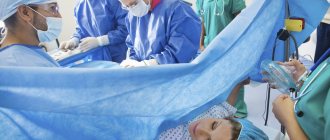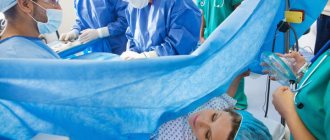After surgical birth, doctors strongly recommend waiting time before the next conception. The body needs to return to normal, the muscle tissue around the uterine scar needs to recover. It is not always possible to follow the doctor's recommendations. Getting pregnant one year after a cesarean section carries certain risks. What to do if you couldn’t wait for the time? What forecasts do doctors give?
After surgical delivery, a woman needs to fully recover
Optimal time
Surgical intervention during labor is usually caused by complications of the current pregnancy. If the reason does not lie in the health of the mother, having children in the future is not prohibited. True, one should not allow pregnancy to recur too quickly. Surgical delivery is a common method of delivery. This is not an easy operation. Caesarean surgery involves cutting through the tissues of the uterus and abdominal cavity. It takes time to restore them. The period of bearing a baby weakens the female body: organs and systems need rest. Considering the characteristics of the female body, doctors are categorically against repeat pregnancy for the next two to three years. On average, 24 months are needed for complete regeneration of muscle tissue at the site of the scar. The suture in the lower abdomen is completely tightened after six months.
Healing of internal tissues is an individual matter. Much depends on the progress of the operation and complications in the postoperative period. If a woman does not want to wait three years after a CS, she needs to consult a doctor about the possibility of getting pregnant earlier.
Gynecologists always have a negative attitude towards pregnancy that occurs before 18 months after surgical birth: the risks are too high. To protect yourself from conception in the first few years after a CS, you need to contact your personal gynecologist to select reliable contraceptives. This will allow you to resume your sex life without fear of consequences.
When is natural childbirth prohibited after surgery?
Previously, doctors would send a pregnant woman who had previously had a cesarean section for a second surgery. Medicine does not stand still; our country has long had experience of natural childbirth after cesarean section. This is only possible if a horizontal incision of the uterus was made during the previous delivery.
If enough time has passed (5 years or more), the risk of scar rupture during natural childbirth is only 0.2%. But there are cases when you can’t do without a CS:
- a woman in labor experiences placental abruption;
- the woman has a too narrow pelvis;
- in the third trimester, an acute form of gestosis is observed (toxicosis, high blood pressure, protein in the urine);
- incorrect position of the baby (transverse, pelvic presentation);
- multiple pregnancy;
- the ultrasound results show that the scar has not healed enough;
- bleeding began;
- unsatisfactory condition of the child;
- A corporal caesarean section was performed.
This is interesting! Only 30% of women who have had a caesarean section agree to give birth on their own during a repeat pregnancy.
Why doctors' recommendations are ignored
Not all patients adhere to the recommendations to avoid pregnancy for the first three years after surgical birth. Many women begin to think about their next pregnancy within a year after surgery. Why? There are several reasons why medical orders are ignored:
- it seems to the woman that the body has fully recovered (the judgment is based on the healing of the external suture and the absence of postoperative health problems);
- the family wants children of the same age;
- The woman is over 35 years old, she is afraid of the growing likelihood of pregnancy complications and the occurrence of pathologies in the unborn child.
The issue of planning should be discussed in advance with the attending gynecologist.
Reproduction issues should only be resolved with a doctor. It is worth voicing your desire to repeat the pregnancy as early as possible. The doctor will examine the patient’s medical history, conduct a general diagnosis of the body, assess the condition of the uterine scar and give recommendations on when to plan conception. Doctors prohibit getting pregnant before a year from the date of surgery, and even exactly one year later, due to the high likelihood of complications occurring during pregnancy and during delivery.
Risks of early conception after CS
Why is it undesirable for the next two years after a caesarean section? Early conception after surgical birth is associated with certain risks:
- Uterine rupture. The scar that appears on the uterus after surgical childbirth takes a long time to heal: on average, a year and a half passes from the moment of surgery to complete healing. Early conception carries a load that tissues that have not fully recovered may not be able to cope with. As the fetus grows, the walls of the organ will stretch, which can lead to cicatricial rupture of the uterus. It is very dangerous.
- Fetal death due to placental abruption. Successful pregnancy and subsequent successful delivery depend on the condition of the placenta. If pregnancy occurs a year after the previous one, a weak placenta may form. This provokes its detachment and other problems that lead to the intrauterine death of the child.
- Miscarriage. Spontaneous interruption occurs if the body is weakened. When pregnancies occur one after another, the body does not have time to recover. After a CS, recovery takes a long time. Surgical delivery is accompanied by significant blood loss compared to natural delivery. This is fraught with iron deficiency in the mother’s body, which is so necessary for the growth of the fetus and its development according to the norms. The lack of resources to support a new life leads to miscarriages and the intrauterine formation of various pathologies.
The likelihood of an unfavorable outcome is very high. However, concerns may remain concerns. Much depends on the exact time that has passed since the surgical birth: in this case there is a significant difference between a year and a year and a half.
Prohibitions on re-pregnancy
In certain cases, a second pregnancy after a cesarean section is strictly prohibited by doctors. These are exceptional situations when a woman’s health has significant problems that directly threaten her life. If the operation had to be performed for the following medical reasons, it is unlikely that she will be allowed to give birth in the future:
- heart disease: arterial hypertension, defects, rheumatism - lead to intrauterine growth retardation, placental abruption, premature birth;
- diseases of the genitourinary system: chronic pyelonephritis, bladder stones, cystitis - threaten premature birth, intrauterine infection of the baby, gestosis;
- problems with the respiratory system: asthma, chronic bronchitis - provoke oxygen starvation of the fetus, delayed development, intrauterine infection;
- diabetes mellitus is fraught with various developmental defects in the fetus;
- Thyroid diseases threaten miscarriages, decreased intelligence of the baby, and fetal developmental defects.
If the section was performed for one of these medical indications, doctors give the young mother recommendations regarding plans for the future. They explain that with such diseases, childbirth is contraindicated. In some cases, right there in the maternity hospital, even before surgery, they may offer a radical method of preventing a new pregnancy - sterilization. If consent is given by the couple, the tubes are tied during the CS so that an unexpected unwanted pregnancy, fraught with complications and consequences, does not occur.
Statistics . Caesarean section is no longer a rare, frightening operation. They resort to it in 20% of cases.
Forecasts
The caesarean section was performed less than a year ago, and a repeat pregnancy occurred - the expectant mother automatically falls into the risk zone. The sooner after the operation conception occurs, the higher the likelihood that a suture rupture of the uterus will occur in the later stages or during labor.
Doctors treat pregnancies that occur early after surgical birth with special caution. They do not always advise continuing the pregnancy. The gynecologist gives recommendations after examining the patient’s health status and examining the uterine suture.
The sooner the pregnancy occurs after the operation, the higher the likelihood that the doctor will insist on an abortion. Termination of a secondary pregnancy is mandatory if less than six months have passed after the CS.
It is very important for an expectant mother to include fresh vegetables and fruits in her diet.
After a year, gestation may not even differ from the previous one. Do not forget about the individuality factor: if the scar is weak, then the gynecologist may recommend terminating the pregnancy, even when 12 months can be counted from the date of the operation. You should definitely listen to the opinion of a specialist. Especially when the surgical birth took place less than eighteen months ago. Making the right decision is a woman’s main task. Early pregnancy does not always end in miscarriage, complications, or ruptures. If a year has passed since the CS and the condition of the scar can be called satisfactory, there is a chance of bearing a child. The expectant mother will have to take care of herself more than during her first pregnancy in order for everything to end well. You need to remember about the likelihood of a favorable outcome when learning about an early second pregnancy: this will help you make an informed decision.
A year ago operation provides an alternative. There are periods that do not leave this alternative: if a woman becomes pregnant four to five months after surgical birth. By this time, only the outer seam has healed, and the inner one remains insolvent. The load on it poses a danger to the life and health of the patient. That's why doctors insist on abortion. A woman can leave a child solely at her own peril and risk.
Planning for a second baby after cesarean section
Adverse events after cesarean section can be prevented by careful and thoughtful planning for future pregnancies. When there are no medical indications for CS, it is necessary to find out the recommendations of your doctor before conceiving a child.
Planning a pregnancy is required taking into account the following requirements:
- In order for the second pregnancy after cesarean to go well , you should use contraception for the next 2 years.
- After this period, you should contact a gynecologist . He will examine the scar and connective fibers on the uterus, give it an assessment, and only then allow conception.
- In addition, it is necessary to implement preventive measures , as well as treat diseases present in the body.
Comprehensive, mandatory planning for repeat pregnancy after cesarean section will prevent adverse consequences and promote a successful birth. Self-treatment and improper adherence to instructions are fraught with irreversible complications.
Features of the second pregnancy after cesarean
When specialists have given permission to conceive after a CS, it is necessary to take into account that the diagnosis and monitoring of the progress of fruiting in such a situation will be different. A woman will have to visit a specialist more often, conduct clinical examinations and constantly conduct ultrasound of the scar.
The occurrence of pain in the abdominal area of a pulling nature or a feeling of discomfort will be a significant reason for hospitalization.
The gynecologist decides whether it is possible to become pregnant and give birth after a cesarean section naturally, only in the last weeks of fruiting.
When more than 5 years have passed since the CS, the management of such patients will be almost no different from other pregnant women. The only question is choosing the method of delivery.
Children after cesarean section are more difficult to adapt to new conditions. There are different opinions on whether it is possible to give birth after a CS or not, but the decision must be made taking into account the health status of the woman in labor and other factors.
Pregnancy after cesarean section - which delivery method to choose?
Doctors' opinions regarding the second delivery after a CS were divided. In order not to make a mistake, you need to conduct a comprehensive diagnosis and undergo consultation with highly specialized specialists.
Natural birth is acceptable:
- when at least 2 years have passed since surgery;
- if the woman does not have dangerous diseases;
- when the course passes without pathological changes;
- with proper presentation of the embryo;
- when pregnancy occurred 12 months after the CS , but the scar on the uterus has finally formed.
If initial signs of pregnancy are detected 8-9 months after the end of the surgical intervention, doctors will suggest termination.
Surgery is indicated when:
- early 2nd pregnancy occurs after a cesarean section (approximately after a year or earlier), during which the scar did not occur;
- the woman has dangerous chronic diseases that are an indication for surgical intervention;
- pathological processes in the early stages of pregnancy;
- age indicators;
- excessively prolonged scarring under the influence of certain unfavorable factors;
- More than 1 fetus is expected.
When a mother or child has medical indications, doctors have a unanimous opinion: surgical intervention is necessary. If no pathological changes are observed, specialists decide to carry out the birth naturally.
How to maintain pregnancy
If only a year has passed between caesarean section and conception, and the woman has firmly decided to keep the baby, she must understand that she will have to make efforts to maintain an “interesting situation.” Simple rules will help with this:
- You need to make an appointment with a doctor as soon as you suspect you are pregnant. This will allow you to monitor the condition of the mother and child, and take timely measures if something goes wrong.
- You need to do an ultrasound more often than during a normal pregnancy. This is necessary to monitor the development of the baby. In addition, ultrasound diagnostics makes it possible to assess the condition of the uterine scar and prevent suture rupture.
- Avoid excessive physical activity. Because of them, the inner seam may come apart. A patient who underwent surgical delivery a year ago is advised to rest throughout her subsequent pregnancy. This rule must be followed even if the scar is determined to be healthy after examination.
Special cases
Life can be so unpredictable that even the most prudent and calculating cannot foresee everything. Especially if it concerns the female body. Special cases of pregnancy after a CS are often diagnosed, which require a professional medical approach and the vigilant attention of the woman herself.
- Two CS in a row
If pregnancy occurs after a second cesarean section, prepare for surgery again. There are only a few people who give birth naturally in such cases, and complications are almost never avoided. The connective tissue at the scar site loses its elasticity, which does not allow the uterus to withstand the load during delivery. In this case, the operation may be performed earlier.
- Three CS in a row
If you are pregnant after 3 caesarean sections, don’t even count on a natural birth. In addition, in recent weeks, given the repeated recurrence of scars, the doctor will suggest you to lie down for preservation. There is too great a risk that the uterus will not be able to withstand such a burden for the fourth time and may rupture as the baby’s weight increases. By observing the condition of the fetus, mother and scar, the gynecologist may decide to perform the operation a little earlier. The modern level of medicine allows us to reduce risks to a minimum.
- Multiple pregnancy
There are often cases when a twin pregnancy is diagnosed after a cesarean section, and in this difficult case, the young mother will also not be allowed to give birth on her own, since the uterus will not bear such a burden. Moreover, if there are three (four, five, etc.) fetuses in the womb. Throughout your pregnancy you will have to be under the constant supervision of doctors, have constant ultrasounds, and in the last stages you will have to go to the hospital.
Caesarean section is a serious abdominal operation that disrupts the course of natural childbirth, so it cannot but have consequences. If pregnancy after this occurs too early or is complicated by some processes, repeated surgical intervention cannot be avoided. At least in most cases it saves lives. Although, with normal pregnancy, a woman can give birth herself, that is, naturally.
Legend or fact? There is an opinion that after a CS, repeat pregnancies often turn out to be multiple. However, there is no exact statistical data about this, and a scientifically similar fact is not confirmed or explained in any way.
Childbirth: is there a choice?
The joy of motherhood is the highest degree of manifestation of love
It is a myth that natural childbirth is contraindicated after a CS. You can give birth on your own even if pregnancy occurs early after the operation - after a year or a year and a half. However, doctors give permission for EP with such a short period of time between the CS and conception only if the condition of the uterine scar is beyond doubt. By assessing the internal suture, the gynecologist determines whether the scar is ready to cope with the stress that accompanies natural childbirth. According to statistics, only 20% of women heal so quickly. When early pregnancy occurs after a CS, surgical delivery is almost always indicated.
If the “interesting situation” recurs when less than a year has passed since the operation, doctors advise terminating the pregnancy. The woman has the right to keep the baby. Under such circumstances, natural childbirth is strictly prohibited. The time recommended by gynecologists between pregnancies is not waited - you need to prepare for a planned surgical intervention if you manage to carry the baby to term.
Regardless of the statute of limitations of the CS, the next pregnancy must end with surgical birth if:
- multiple pregnancy;
- there are risks of muscle tissue divergence;
- pregnancy is complicated by pathological conditions of the mother/baby;
- two or more CS in history;
- the age of the woman in labor exceeds 35 years;
- after a previous CS, complications related to scar healing arose.
It is important to talk to your doctor about your birth options. Gynecologist-obstetricians welcome natural childbirth and do everything possible to make it a reality in each specific case. However, sometimes this option of delivery is not possible due to high risks for the mother/fetus. You should always listen to doctors. Especially in early pregnancy after a CS. Failure to follow the recommendations can lead to uterine rupture, which can lead to complications and death.
Preparing for pregnancy
So, if you are planning to give birth to a second child after a cesarean section, first of all you need to visit a gynecologist and undergo additional examination. Girls, which of you did this? I'm sure there are only a few. But this behavior is fundamentally wrong, because many complications can be avoided if pathologies are identified and eliminated at the planning stage.
At your appointment, the doctor will examine your scar visually, take tests for sexually transmitted infections, and also prescribe the following types of studies:
- Ultrasound of the pelvic organs;
- hysteroscopy;
- X-ray hysterography.
An ultrasound will necessarily measure the thickness of the scar and evaluate the tissue from which it was formed.
Normally, the scar consists of muscle tissue, but sometimes connective tissue is mixed in. Such a suture is considered untenable and can separate under the pressure of the fetus. In addition, the fallopian tubes are examined for the presence of adhesions, which often form after surgery.
Hysteroscopy involves inserting a special device into the uterine cavity - a hysteroscope equipped with a camera (How is hysteroscopy performed and why is it needed). The doctor examines the internal suture and the walls of the uterus. A barely visible scar indicates maximum recovery of the body. With a predominance of connective tissue, it has a white tint.
Hysterography is a procedure during which a contrast agent is injected into the uterus. Using X-rays, a picture is displayed on the monitor showing the condition of the uterus and its tubes. A pathological change in the scar may be indicated by defects in the filling of the uterine cavity with solution or uneven contours.
After assessing the results of all tests, the doctor will decide on the possibility of another birth.
Attention! It is also not advisable to delay the birth of a child after a caesarean section, just as it is not advisable to rush. After 10 years, scar tissue begins to atrophy and become thinner, which increases the risk of suture dehiscence. The optimal period for re-pregnancy is from 2 to 10 years after surgery.
A couple of months before conception, a woman needs to stick to a diet and exercise to strengthen and increase the elasticity of the muscles of the uterus and abdominal muscles.









